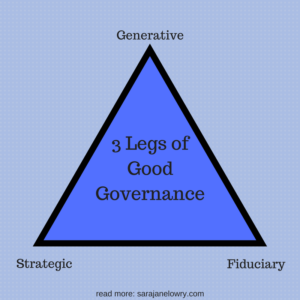A high-performing board is an entity nonprofits dream of having. Is your nonprofit’s board of directors living up to expectations? And, are your expectations appropriate for them?
When staff and board leadership are disappointed in their board’s performance, it’s often because they have not made their expectations clear – particularly in fundraising. High-performing boards build a culture that everyone works within and understands. What’s yours?
High-performing boards have a strong board culture
When there is a reluctance to truly share the culture and expectations of board members during the interview  process, you know that you are setting up a culture that won’t serve you well. I’ve heard about why from governance committees: Fear. Fear that a potential board member will be scared away. But in worrying about scaring them off before they join, you’re forgetting one very important factor. And that factor is the passion they feel for your sector. And that they believe you have the solution to an important community issue. But, that’s just the beginning. A strong board culture includes:
process, you know that you are setting up a culture that won’t serve you well. I’ve heard about why from governance committees: Fear. Fear that a potential board member will be scared away. But in worrying about scaring them off before they join, you’re forgetting one very important factor. And that factor is the passion they feel for your sector. And that they believe you have the solution to an important community issue. But, that’s just the beginning. A strong board culture includes:
- sharing a set of values that includes doing the right thing for the right reason,
- encouraging questions and avoiding “group think,”
- being willing to challenge management when making strategic decisions.
Therefore, to build a high-performing board of directors, you must be intentional with whom you choose. Start with how you present the opportunity and responsibilities, from the earliest stages of the recruitment process.
Ensure the nominating committee is considering your nonprofit’s unique needs at this point in its organizational development.
I’m not a big supporter of a board “matrix” in governance recruitment, unless it focuses on whether they can help you achieve your strategic goals over the next 2-3 years. For most nonprofits, fundraising is a constant need. So your matrix can include networks you’re trying to reach into, new partnerships, leadership skills, or special talents that help you achieve mission. Be careful in assigning skills to your matrix – if you need a financial person because you’re trying to figure out your earned revenue model, make sure it’s one that has skills in that specific area, and that they really want to help you figure that out.
Talk through responsibilities – including fundraising – during first meeting with potential board members.
You should have written statement of roles and responsibilities, They should include expectations for engagement, giving and fundraising. Other questions include: are board members also expected to participate in events? Attend a certain percentage of meetings? Serve on committees or task forces? Talk through each of these points with potential members so expectations are well-defined.
Explain the three legs of good governance: fiduciary, strategic, and generative.
Many boards get stuck in the weeds of fiduciary oversight of your assets. Get a board treasurer they trust to report out on the important stuff. Make sure you’re looking at funding diversity and sustainability (see my post on financial sustainability). Strategy, the se cond leg, includes setting priorities for your organization, developing and improving various strategies you’re using to meet your mission, and then monitoring their performance. This is often delegated to staff to monitor with very little board oversight. Spend at least 20 minutes of your board meeting on strategic discussion. The third leg of good governance is generative: not just doing work better; but ensuring your organization does better work. Generative thinking includes probing assumptions held in how you decide things, and living the organizational values that should be driving strategy and tactics. Generative mode is often where board members spend the least amount of time, and yet that’s where real governance truly happens. It’s how you make leaps forward. Remember, boards exist to supplement management expertise by asking a different set of questions. High-performing boards spend time in generative mode.
cond leg, includes setting priorities for your organization, developing and improving various strategies you’re using to meet your mission, and then monitoring their performance. This is often delegated to staff to monitor with very little board oversight. Spend at least 20 minutes of your board meeting on strategic discussion. The third leg of good governance is generative: not just doing work better; but ensuring your organization does better work. Generative thinking includes probing assumptions held in how you decide things, and living the organizational values that should be driving strategy and tactics. Generative mode is often where board members spend the least amount of time, and yet that’s where real governance truly happens. It’s how you make leaps forward. Remember, boards exist to supplement management expertise by asking a different set of questions. High-performing boards spend time in generative mode.
Make it clear during board member orientation that fundraising is a priority.
Leadership staff should discuss and share fundraising goals and challenges with new board members. We can’t expect board members to excel at something unless we give them the appropriate training. Even if they’re more experienced as a board member, they may need a refresher in major gift fundraising. Once onboard, have them meet one-on-one with development staff to discuss strategies.
A high-performing board supports and guides new members in their role.
Staff and veterans of the board should assist new members in focusing on strategic priorities. Create a plan to help them to do so. Start a buddy system with the new member where they can ask questions with a more seasoned member. A high-performing board always seek third-party training on good governance. Try bringing someone in to help the board develop their fundraising skills.
Have board members evaluate themselves – and set goals.
Led by the board chair or vice chair, it’s a good idea to ask each member – and the board as a whole – to evaluate their goals and performance. In addition, having them set thoughtful goals on how they’d like to engage in the coming year gives you something to work with as you strive to keep them involved. A high-performing board ensures that this role be led by their board peers on the governance or nominating committee annually.
By strategically recruiting the right people for your board, making your expectations clear and helping them hold themselves accountable, you will be well on your way to a high-performing board strategy.
Sara Jane Lowry is a local consultant and coach to nonprofits. Reach her at [email protected] or (412) 821-0242.




